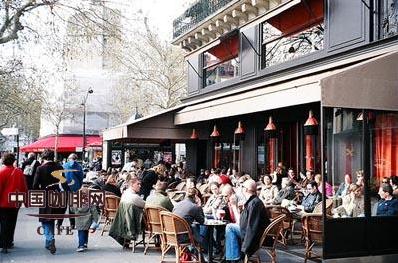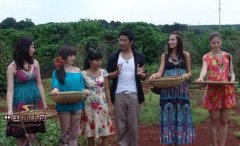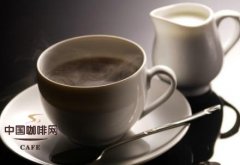Experience in cafes all over the world Cafe Prokopu, France

In addition to being suitable for romance, cafes are also rich in creativity, inspiration, theory and everything related to ideas, not only because coffee itself is brain-exciting and energetic, but also because it has a continuous tradition.
It is said that the world's first cafe, called Kiva Han, opened in Mecca in 1475. Subsequently, coffee was introduced to Egypt, North Africa, Turkey and other Arab countries. Coffee drinking has become popular, and many people gather in cafes to drink coffee, discuss current politics, and attack the government, and cafes have become a source of opinions and ideas.
When the cafe met these cultural people, the thought went off in the collision, so there were many masterpieces that attracted worldwide attention and ignited the ideological trend of social change. The huge energy nurtured by the combination of cafes and cultural people is sometimes unimaginable.
Prokopu Cafe, France
Encounter Voltaire, Rousseau, Hugo, Balzac
Leprocope Cafe is now a business card in Paris, France, the first cafe to open in Paris. The relationship between the cafe and the cultural people makes it full of legendary color.
In the 18th century, European Enlightenment thinkers Voltaire, Rousseau and Diderot, the author of the world's first encyclopedia, wrote works here that influenced the process of revolution and social development in Europe and the United States. Robespierre, Danton and Mara, the three giants of the French Revolution, also talked with other revolutionaries about the ideal of social change and drew their own blueprints. It is said that Napoleon came here and left a cap for drinking coffee; later, there were a group of equally heavyweight writers, actors, gentlemen and ladies, such as the great writers Hugo and Balzac.
A cafe contains so many events that we can imagine the importance of this cafe in the eyes of the cultural people, so much so that a literary publication was later named Prokopu.
Four Cat Cafe in Spain
Encounter Picasso
Just as Prokopu is to Paris and 4 Gats Cafe is to Barcelona, it has the same symbolic significance. The four Cat Cafe has another name: Picasso Cafe. Because Picasso has been here since the age of 17, he spent three years down and out here, when Picasso used to draw exaggerated and strange cartoon portraits of his friends over a cup of coffee and post them on the store wall. In addition, he designed advertisements and menus for the cafe, which now has a menu designed by Picasso for the owner on its wooden blackboard.
At that time, Barcelona (late 1890s) was the most enlightened city in Spain, and some cultural people also liked to meet here. They exchanged ideas and collided with ideas. It was in this relaxed, lively and trendy atmosphere that Picasso came into contact with various cultural schools and thoughts, began his painting career, and with the help of these friends, held his first painting exhibition in his life. Brought him a great reputation.
French Lancasel Cafe
Encounter Van Gogh
If the four Cat Cafe is famous for Picasso and is also known as the "Picasso Cafe", then the French Cafe Lankasal Cafe, another name "Van Gogh Cafe", has the same reason. This cafe is famous for another world-famous painter, Van Gogh.
In 1888, Van Gogh was tired of city life in Paris and came to Arles, a small town in the south of France. In September 1888, he stayed in the Lancassel Cafe, also known as the "Night Cafe" because it was open all night. The environment of the cafe inspired him. Van Gogh said: "the exterior of a cafe has a balcony illuminated by a big gas lamp in the blue night sky and a blue sky shining with stars in a corner." I often think that night is more lively and colorful than day. " As a result, the famous painting "Cafe at Night" was born.
Today, the cafe has changed its name to Van Gogh Cafe and has become a must for tourists to Al. The cafe still retains the appearance of Van Gogh's paintings more than a hundred years ago, and the story of Van Gogh and the cafe has become a local legend.
Shanghai Public Coffee Cafe, China
Encounter Lu Xun, Tian Mei, Ding Ling and Mao Dun
Around the 1920s, coffee shops became a cultural craze in Shanghai, and many cafes modelled on Paris appeared in the French and Japanese concessions. at that time, the most famous was the public coffee cafe on Toronto Road in Hongkou. In the days when white terror was extremely serious, some secret meetings of the literary and art circles were held in public coffee cafes. According to Zheng Boqi, "the public coffee shop is run by foreigners, because most Chinese people do not go to this place, and foreigners pay little attention to coffee drinkers, so meetings are safer." Therefore, not only the preparatory meetings of the "League of the left" were held many times in the public coffee shop, but also other left-wing cultural groups also held meetings here. Lu Xun, Tian Mei, Ding Ling and Mao Dun were all guests of this cafe.
In mid-October 1929, the League of the left held its first preparatory meeting in a small room on the second floor of the public coffee shop, which could accommodate 12 or 13 people. Mr. Lu Xun also attended. On February 16, 1930, the party organization held another preparatory meeting here, that is, the "Symposium on the people of the Shanghai New Literature Movement". According to Lu Xun's Diary: "drinking coffee in the afternoon with Rou Shi and Xuefeng" refers to going to the public coffee shop to attend the last preparatory meeting of the League of the left.
Banpo Village Cafe, Nanjing, China
Founded by painter Guo Haiping, artists, writers, poets and scholars are regular guests.
Banpo Village Cafe and Pioneer Bookstore are two business cards of folk culture in Nanjing.
In the 1990s, painter Guo Haiping founded Banpo Village Cafe, but now it has changed hands, but it has always been one of the most artistic landmarks in the city. For more than a decade, artists, writers, poets, experts and scholars at home and abroad exchange and talk here, taking away warmth, inspiration, creativity and so on.
Japanese Cafe
The only country that has an official coffee festival
Dutch missionaries and merchants brought coffee to Japan around 1630, but at first the Japanese did not accept the strange-tasting drink at all. Coffee did not become popular until the Meiji Restoration era and the trend of "Western learning" in Japanese society. At the same time, cafes have become a favorite place for young people and activists to meet and communicate. Japan is the only country with an official coffee festival, which is celebrated every year on October 1.
British Cafe
Laid the foundation for the earliest publishing industry.
The first coffee shop in Europe appeared at Oxford University in 1650 and was opened by a Lebanese Jew. Then London's cafes sprang up, and by 1700 there were more than 2000. As the first place to provide equal exchange and dialogue for the public, cafes are very popular, and British cafes have laid a solid foundation for the earliest publishing industry. At that time, the cafes had the flavor of ancient Chinese inns.
American Cafe
Like the popular fast food culture.
The first coffee shop in the United States was the London Cafe, which opened in Boston in 1691. Today's American cafes have their own unique form and atmosphere. Like the popular American fast food culture, most American cafes also embody a fast-paced way of life of American society. For example, Starbucks, which attracts young hipsters with its unique style and atmosphere, is one of the most representative American-style cafes.
Important Notice :
前街咖啡 FrontStreet Coffee has moved to new addredd:
FrontStreet Coffee Address: 315,Donghua East Road,GuangZhou
Tel:020 38364473
- Prev

Chinese coffee culture Hainan native coffee history and culture
Visit the thousand-year-old ancient pagoda and ancient temple, taste the fragrant and authentic Hainan local coffee, and personally dig up and roast sweet potatoes for 9 days. Our "Tourism Weekly" launched a self-driving leisure trip, and the cyclists are known as Chengmai, which is known as the back garden of Haikou. I really feel the leisure trip with both heavy history and culture and delicious food. Yuan Lan, a trainee reporter of this newspaper, reported that Sister Ta Zai Youyou
- Next

Coffee legends and anecdotes so where did the trend of drinking coffee come from?
Coffee has always been popular in history. Napoleon called coffee an intellectual drink, and it was said that Voltaire, a French philosopher and writer, drank 72 cups of coffee a day. At one time in Turkey, if the husband could not provide coffee for the wife, the wife could divorce her husband. In 1735, the German composer Johann Sebastian Bach completed his coffee chorus.
Related
- How did the Salvadoran coffee industry develop in Central America?
- What exactly does the golden cup extraction of coffee mean?
- The Origin of Coffee flower
- [2023 Starbucks World Earth Day] there are more meaningful things besides free Starbucks coffee!
- What kind of coffee is there in Spain? 9 Flavors of Spanish Coffee
- Aromatic African coffee| Kenya's coffee culture and historical production area
- Liberica Coffee Bean knowledge: the characteristics of Liberian Coffee beans of the three original species of Coffee beans
- The origin and formula of Spanish latte introduces the taste characteristics of Bombon coffee in Valencia, Spain.
- How to adjust the solution of over-extracted coffee
- What is the tasting period of coffee beans? What is the period of coffee and beans? How should coffee wake up and raise beans?

